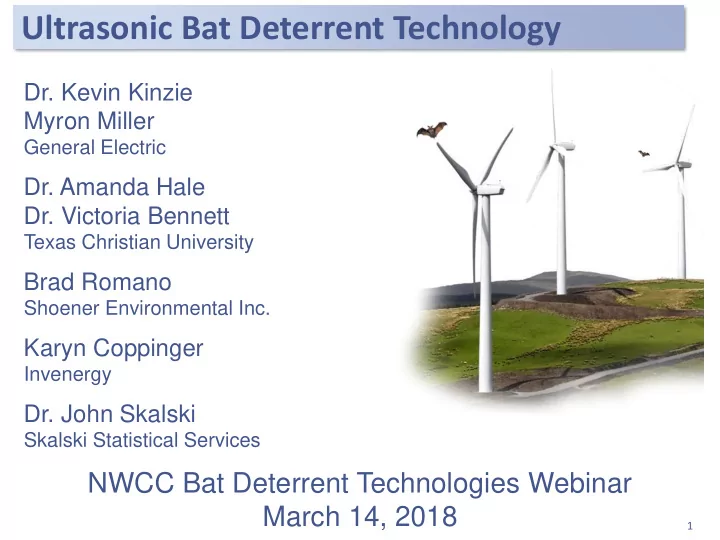

Ultrasonic Bat Deterrent Technology Dr. Kevin Kinzie Myron Miller General Electric Dr. Amanda Hale Dr. Victoria Bennett Texas Christian University Brad Romano Shoener Environmental Inc. Karyn Coppinger Invenergy Dr. John Skalski Skalski Statistical Services NWCC Bat Deterrent Technologies Webinar March 14, 2018 1
Additional Project Support California Ridge Wind US Department of Energy Wolf Ridge Wind US Fish and Wildlife Service Illinois Department of Natural Resources US Forest Service Conservation Canine Envisibat-4D Terraform Power University of Illinois – Champaign-Urbana 2
DOE Project Goals 1) Develop causal bat behavioral characteristics to Flight Room Behavioral Testing to understand: Document Response to Ultrasonic • How bats respond to various ultrasonic stimuli Signals • Deterrent effectiveness on different species and in different bat environments (i.e. foraging, near turbines) • How bats interact with operating wind turbines with and without the deterrent operating using video imaging and 3D flight mapping Ground Based Testing for Demonstration of Redesigned Deterrent 2) Redesign the GE deterrent system based on 3D Flight Mapping of Bat new behavioral and technology learnings and Motion Around Turbine test the efficacy in a operating wind farm Designed by Industry Leading Turbine Manufacturer Tested at Major US Wind Farm Evaluated by World Class Biologists and Statisticians Field Testing of Redesigned Deterrent Installed in Operating Wind Farm 3
Characteristics of GE Ultrasonic Device Key Design Criteria • Overcome limitations of previous devices • Broadband ultrasonic emission Directivity pattern of • Wide directivity field GE device • Compact; easily mountable on turbine system • Less expensive than curtailment solutions • Robust and easy maintenance Typical transducer based directivity pattern High speed air jet device provides wide frequency range, broad coverage, and reliability • 10x more airspace volume covered for each deterrent device compared to transducer based system • No electronics exposed to weather • Simple hardware mechanisms with easy operations and maintenance • Proper deterrent operation easily verified with standard instrumentation • Capable of installation on non-GE turbines 4
Proof of Concept Testing • Generates ultrasound in the range of 20 kHz-50 kHz • Prototype tested in bat habitat (WY & IN) by WEST, Inc. • Study provided clear and unambiguous evidence that the deterrent device was effective with this application Deterrent IR camera “During every treatment, bats would move out of the airspace being filled with sound within 5-10 seconds. In IR light most cases they remained at a distance of approximately 40 m away from the device, where they appeared to forage and behave normally. “ – WEST, Inc. Study Report, 2012 Deterrent Off Deterrent On The effectiveness of the deterrent was confirmed with the IR camera results and night vision goggles while observing little brown bats ( Myotis lucifugus ) 5
Technology Development Timeline Initial Test pulse signal deterrent on ground (TX) Move/test deterrent placement on design and and in turbine turbines, study bat activity (IL) pilot testing deployment (IL) (WY, IN) Pre-2013 2013 2014 2015 2016 Future Develop pulse Available for full-scale First deployment system; study deployment at on turbines; test constant and pulse operational wind effectiveness (IL) (TX, IL) facilities 6
Deterrent System Installation 7
Field Study Design • Study at California Ridge included 12-20 of 134 turbines • 3 internal year study (2013-2015); 1 year DOE funded study (2016) • Study design: – Equip 12-20 turbines with deterrent, operate at normal cut-in speed – Feather all study turbines below cut-in – Deterrents operational under all wind conditions during nighttime hours for treated turbines – Thermal imaging data to evaluate bat behavior at deterred and non-deterred turbines • 2013 – 4-night treatment blocks; 10 of the 20 deterrent-equipped turbines operated as deterrent treatments and the remaining 10 operated as control turbines; Switch control and treatment turbines after 4 nights; visual searches by human searchers • 2014-2016 – 6-night treatment blocks; control and treatment groups switched after 3 nights; treatment and control groups re-randomized every 6 days; combination of human and dog/handler search teams (over 95% searcher efficiency) 8
Acoustic Signal Characteristics Steady Signal Pulsed Signal 9
Current Research Findings Approximate fatality reduction ➢ 30 – 40% reductions in all-bat estimated fatality rates; ~50% reduction in non-eastern red bats (data dominated by hoary/silver-haired); little to no effect on eastern red bats ➢ Shifts to nozzle placements and nozzle quantity consistently moving effectiveness in desired direction ➢ Similar effectiveness for pulsed and steady systems ➢ Effectiveness is reduced with distance; consistently 20 – 30 meter effective range across all bat activity studies ➢ Bats that do fly through treated airspace have simpler, straighter flights than those passing 10 through same airspace while deterrents off
Reduction of Bat Fatalities California Ridge Wind, Illinois * = estimated reduction was significantly different than zero (p < 0.05) Error bars +/- 1 standard error 11
Reduction of Bat Fatalities California Ridge Wind, Illinois * = estimated reduction was significantly different than zero (p < 0.05) Error bars +/- 1 standard error 12
Flight Path Mapping in Turbine Airspace California Ridge Wind, Illinois 13
Flight Path Mapping in Turbine Airspace California Ridge Wind, Illinois 14
Flight Path Mapping in Turbine Airspace California Ridge Wind, Illinois - 2016 WIND WIND 15
Development Status • No system mechanical failures in 4 years of operation • Prototype system is available for full-scale deployment • System is capable of installation on non-GE turbines • Commercialization plan depends on regulatory guidance and market interest. 16
Questions? 17
Recommend
More recommend